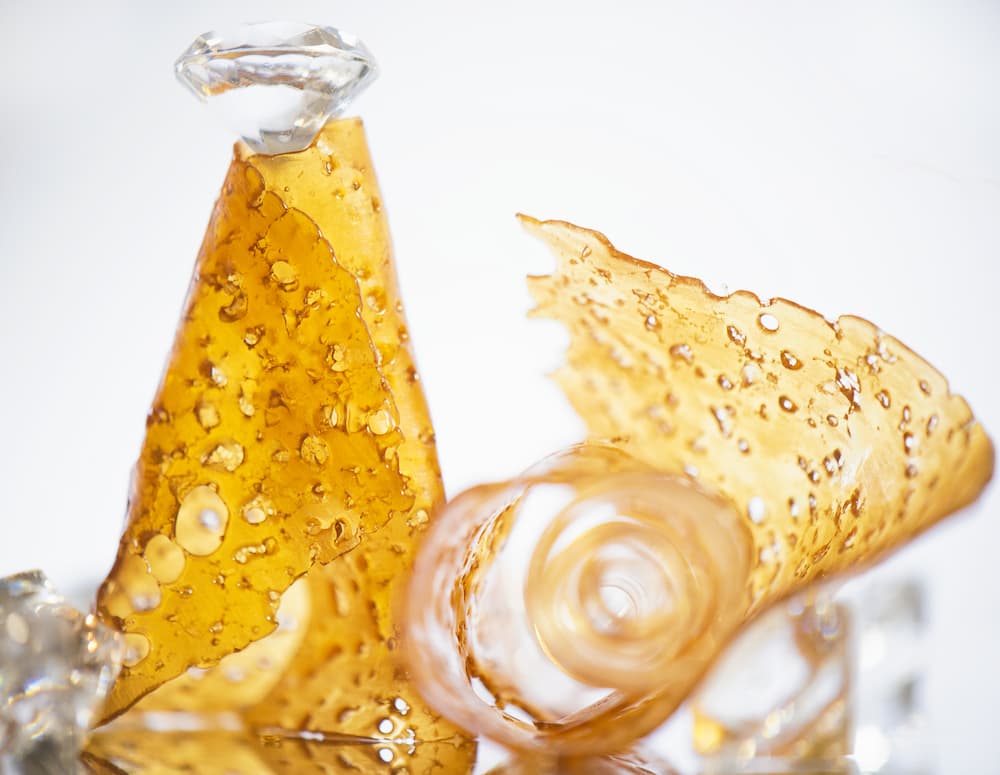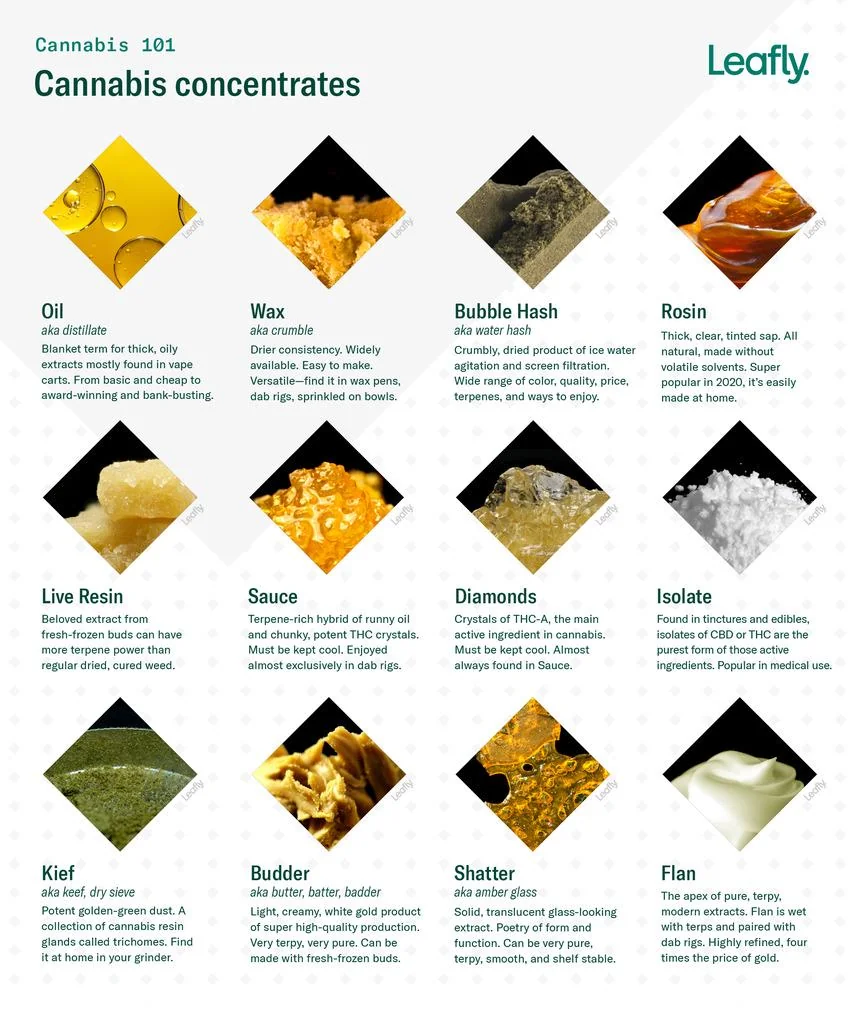- You have no items in your shopping cart
- Continue Shopping

Navigating the diverse world of cannabis can often feel overwhelming, particularly with the myriad options available today. As you browse The Dope Warehouse, you may be greeted by the rich variety of cannabis bud and the enticing allure of various concentrates. Each form has its unique characteristics, effects, and methods of consumption, making it essential to understand their differences to maximise your experience.
The Essence of Cannabis: Bud vs. Concentrates
At its core, cannabis bud remains the traditional and most recognisable form of the plant. It consists of the flowers that growers harvest, dry, and cure. In contrast, concentrates represent a modern approach, extracting the essential compounds—cannabinoids and terpenes—from the plant. This process yields products that often exhibit higher potency and offer a range of consumption methods.
What Are Cannabis Concentrates?
Cannabis concentrates are highly condensed forms of the cannabis plant, primarily composed of the plant’s trichomes. These tiny resin glands are rich in cannabinoids, terpenes, and flavonoids, making concentrates particularly potent. The extraction processes employed to create these concentrates can be classified into two main categories: solvent-based and solvent-less.

Solvent-less Concentrates: Natural and Pure
Solvent-less concentrates utilize mechanical methods such as agitation or heat to effectively separate resin heads from the plant material. This approach ensures that no chemical residues remain, making it particularly appealing to health-conscious consumers.
- Dry Sifting: This ancient technique involves shaking cannabis buds over fine mesh screens, allowing trichomes to fall through and collect as kief, a flavorful and potent product.
- Ice Water Extraction: Also known as bubble hash, this process uses cold water and ice to gently agitate the cannabis, facilitating the separation of trichomes from the plant material. You can then use the collected trichomes to create ice water hash, celebrated for its purity.
- Rosin Pressing: This method employs heat and pressure to extract trichomes without solvents. A rosin press or even a hair straightener at a low temperature can yield a potent product, allowing you to enjoy cannabis without any chemical additives.
Popular Types of Solvent-less Concentrates
- Rosin: Extracted using heat and pressure, rosin is praised for its purity and flavour.
- Hash: This traditional concentrate is made by collecting trichomes, resulting in a potent product with rich flavour profiles.
- Kief: Represents the simplest type of concentrate, consisting of unadulterated trichomes that you can collect using a grinder. These resin glands easily detach from the cannabis flower during storage or handling. To maximize your kief yield, invest in a grinder equipped with a kief-catcher. You can smoke kief on its own in a spliff or a bong, or mix it with other cannabis forms for an extra kick. For a more intentional collection, gently shake cannabis flowers over a fine sieve or use the blender method: blend the flowers with ice water to separate the kief from the plant material.
- Charas: Producers craft charas from fresh cannabis buds rather than dried flowers. To create this concentrate, you hand-roll the buds, releasing their sticky resin. Charas enjoys particular popularity in the Indian subcontinent, where users shape it into balls or sticks and traditionally smoke it in a chillum. To make charas, first wash your hands with unscented soap. Then, apply pressure to the fresh buds to release the resin. Afterward, form the resulting resin into smooth, shiny pieces that are both visually appealing and potent.
- CBD Isolate: CBD Isolate offers a highly purified form of cannabidiol that contains only CBD without any other cannabinoids, terpenes, or fats. This extraction process prioritizes purity, making it one of the cleanest forms of CBD available. Typically, it comprises around 10% of total cannabinoids by weight and is produced using solventless techniques to avoid contamination.
Solvent-Based Concentrates: High-Potency Options
Solvent-based concentrates harness the power of chemical solvents to extract cannabinoids and terpenes from cannabis plant material. This extraction method typically yields higher concentrations of active compounds, resulting in potent products. However, it is essential to ensure that all residual solvents are thoroughly purged from the final product for safety.
- Hydrocarbon Extraction: This popular method uses flammable solvents like butane and propane. While these substances carry inherent risks, strict safety regulations and automated technology help mitigate dangers. Hydrocarbons have lower boiling points, allowing operators to work at lower temperatures and preserve sensitive terpenes, resulting in a fuller flavor profile.
- Supercritical Carbon Dioxide Extraction: This eco-friendly method employs carbon dioxide in a supercritical state, exhibiting properties of both a liquid and a gas. Although this method requires a significant upfront investment in equipment, its tunable nature allows for precise extraction, enabling operators to separate terpenes at controlled temperatures.
- Ethanol Extraction: Ethanol extraction utilizes high-proof alcohol to efficiently remove cannabinoids while stripping away excessive chlorophyll. Recognized as safe for food processing, this method proves cost-effective and enables producers to process large volumes of biomass.
Common Types of Solvent-Based Concentrates
- BHO: Butane Hash Oil (BHO) serves as a popular solvent-based concentrate used to create various forms, including shatter, wax, and budder. While consumers enjoy its potency, making BHO at home can be risky due to the flammable nature of butane, which can lead to combustion.
- Shatter: Firstly, shatter presents a glass-like concentrate that boasts high potency. Moreover, it features a brittle texture and exceptional purity.
- Wax: In contrast, this concentrate has a softer, more malleable texture. Additionally, it often retains more terpenes, which provide robust and delightful flavours.
- Live Resin: Similarly, producers create live resin from fresh, flash-frozen cannabis. Consequently, this method preserves the plant’s natural terpenes, resulting in a more aromatic and flavorful experience.
- Sugar and Crumble: Furthermore, these flavorful products boast a rich terpene profile. Sugar and crumble range in colour from pale yellow to deep amber. Notably, crumble resembles sugar clumps. This dryness results from a unique extraction process that uses lower heat for extended periods. As a result, this method minimises the risk of mould while maintaining potency. Importantly, sugar and crumble can contain up to 90% THC, offering a potent experience.
- Rick Simpson Oil (RSO): Additionally, RSO represents a highly potent cannabis extract known for its elevated THC content. This thick, tar-like substance maintains a full spectrum of cannabinoids and terpenes. People often seek RSO for its potential therapeutic properties, produced through a concentrated extraction process that uses solvents, resulting in a powerful oil typically sold in syringes.
- THC Distillate: Finally, THC distillate utilizes a solvent-based method to dissolve cannabis into a crude oil. This distillation process produces a tasteless, odorless concentrate containing between 95% and 99% pure THC. However, it’s worth noting that cannabis distillation requires extensive post-processing, often more than most other concentrate methods.
Potency: Understanding the Strengths
One significant distinction between cannabis bud and concentrates lies in their potency. While bud typically contains between 10% to 25% THC, concentrates can soar to levels ranging from 50% to over 90%. This heightened potency translates into a more intense experience, allowing users to achieve their desired effects with smaller doses.
Moreover, For medical users or seasoned recreational consumers, concentrates can provide quicker relief or a stronger high. However, the increased potency also necessitates careful dosing. For those new to concentrates, beginning with lower-potency options, such as CBD-rich concentrates, hash or low THC bud can ease the transition. It’s crucial to listen to your body and determine what works best for you.
Methods of Consumption: Versatility Matters
Another notable difference lies in the variety of consumption methods available for each form. Cannabis bud can be smoked, vaporised, or even incorporated into edibles. While these methods are well-known and widely accepted, concentrates offer innovative consumption options.Dabbing is a popular method for consuming concentrates. This involves heating a small amount of extract on a hot surface and inhaling the resulting vapour. Although dabbing provides an intense and immediate experience, it requires specialised equipment, which may be daunting for newcomers.
Alternatively, you can vapourise concentrates using pens or devices designed for oils and waxes. This offers a discreet and efficient way to enjoy cannabis without combustion. Ingestible oils and tinctures also make excellent options, providing slow and prolonged effects. Tinctures, which you take sublingually, deliver rapid onset while allowing for easy dosing.
The Role of Terpenes
Flavour plays a crucial role in the cannabis experience, often defined by the plant’s unique terpenes—volatile compounds that contribute to its aroma and taste. Cannabis bud is rich in these aromatic oils, providing a diverse sensory experience that ranges from fruity and floral to earthy and piney. However, the extraction process used to create concentrates can sometimes strip away these terpenes, leading to a less flavourful product. Fortunately, many producers now reintroduce terpenes during or after extraction, enhancing the flavour profile of concentrates. For example, live resin, which retains more terpenes, often delivers a richer flavour than other concentrates.
Cleaner Choices
For health-conscious consumers, the choice between bud and concentrates may hinge on health considerations. The extraction process for concentrates removes much of the plant material, resulting in a cleaner product with less tar and harmful byproducts associated with combustion. This aspect proves particularly beneficial for those who experience lung irritation from smoking bud. Vapourising concentrates provides an even cleaner experience, as it heats the product without reaching combustion temperatures. This method minimises harmful toxins while delivering potent cannabinoids and terpenes.
Making the Choice: What’s Right for You?
Choosing between cannabis bud and concentrates ultimately depends on your individual preferences and consumption goals. If you cherish the ritual of smoking and appreciate the nuanced flavours of bud, that may be the right choice for you. Conversely, if you seek a powerful, discreet, and versatile method of consumption, concentrates may better suit your needs.
For newcomers, starting with cannabis bud or lower-potency concentrates can provide a comfortable introduction to the world of cannabis. As you grow more familiar with your preferences and tolerance, you can explore the broader range of concentrates available.
Elevate Your Cannabis Experience
In summary, both cannabis bud and concentrates offer distinct benefits, catering to various consumer needs and preferences. While bud provides a rich and traditional experience, concentrates deliver potency and versatility. By understanding these differences, you can make informed choices that enhance your overall cannabis experience.
Disclaimer: This content is for educational purposes only. The information provided is derived from research gathered from external sources.
- https://www.greenfieldscannabisco.com/blog/how-using-flower-along-with-concentrates-enhances-and-prolongs-the-experience/
- https://www.leafly.com/news/cannabis-101/5-differences-between-cannabis-concentrates-and-flower
- https://mediabros.store/blogs/news/solvent-vs-solventless-concentrate
- https://www.acslab.com/retail/cannabis-concentrates-guide
- https://livwell.com/blog/what-is-rso
- https://www.maratek.com/cannabis-oil-extraction-and-recovery-blog/understanding-cbd-isolate-and-distillate
- https://silverstemcannabis.com/news-articles/cannabis-concentrates-vs-flower-a-comprehensive-overview
- https://mtrevenue.gov/cannabis/education/marijuana-and-the-entourage-effect/
- https://kindmedsaz.com/blog/flower-vs-concentrate/
- https://www.zamnesia.com/content/622-ultimate-cannabis-concentrates-guide
